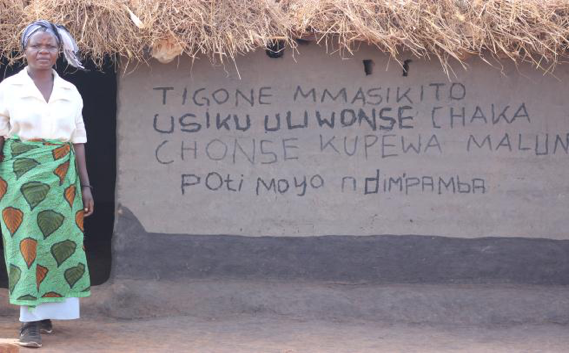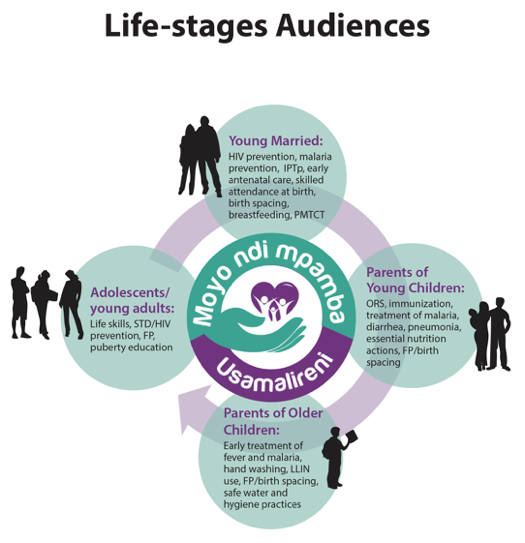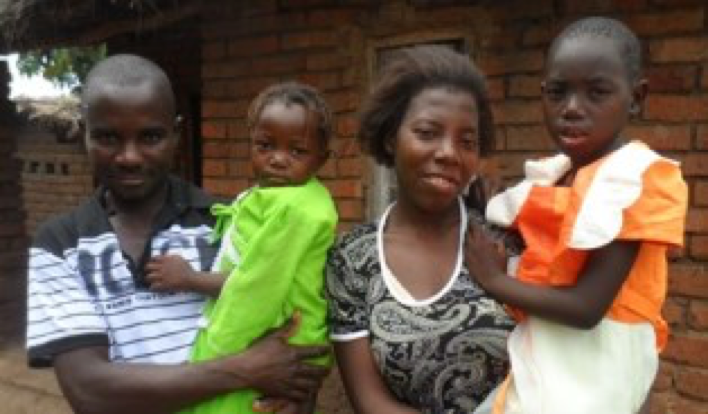Malawi’s Life Is Precious Campaign
The Life is Precious (or Moyo ndi Mpamba) campaign in Malawi promotes healthy practices in six priority health areas:
- Malaria
- Maternal, neonatal and child health (MNCH)
- Water, sanitation and hygiene (WASH)
- Family planning
- HIV and AIDS
- Nutrition

This sign reads, “Let’s sleep under a net every night throughout the year to prevent malaria – Life is precious.
Implemented by the Support for Service Delivery Integration (SSDI) Communication Project, a USAID-funded project with the Ministry of Health, the campaign is implemented in 15 districts. SSDI Communication, which began in 2011 and runs into 2016, is managed by the Johns Hopkins Center for Communication Programs (CCP) in partnership with Save the Children.
Inquire
SSDI Communication began by reviewing relevant research on health and the many communication strategies already in existence. These included communication strategies for malaria, nutrition, maternal and neonatal mortality and morbidity, HIV and AIDS, and family planning. SSDI also designed and conducted a population-based survey and qualitative research in the 15 districts where it worked.
They found that well-being is associated by most Malawians with smaller families, self sufficiency, food security and the absence of disease. They also found that while many people were aware of the government’s recommended health practices, many did not believe in the efficacy of these practices or did not think that they were able to adopt them. A summary of key findings from the SSDI research by health area includes:
- Malaria: Insecticide-treated nets were considered highly efficacious, although most people thought they might not be safe. Nonetheless, the majority of children under five slept under nets. Overall, three-quarters of mothers sought medical treatment for a child with fever. However, only about one-third of mothers recognized the need to take a feverish child to a health facility within 48 hours of the onset of fever.
- Family planning: Most men and women know of at least one modern family planning method and approve of using them. On average, men and women would like to have 4.1 children. Most men and women have used a modern contraceptive at some time in their lives and about half were using contraceptives at the time of the studies. About three-quarters of men and women believed others they know use contraception.
- Maternal health: Overall, knowledge of danger signs associated with pregnancy was very low; approximately one-fifth of respondents were unaware of any danger signs for the child or the mother. Among women who gave birth in the past five years, 98% received some antenatal care; and childbirth was attended by a trained medical professional. Over 80% of births took place in a hospital or health facility.
- Water and sanitation: Three-quarters of respondents knew that improper hand washing can cause diarrhea and about half associated it with cholera transmission. About 90% reported washing their hands after using the toilet, 80% before handling food, but less than 30% after cleaning a defecating child. Most people thought that poor access to safe water was the greatest barrier to good health.
- HIV and AIDS: Most adults believed that they could reduce their risk of HIV through abstinence, faithfulness and condom use; more than 90% knew that mother-to-child transmission of HIV could be prevented. The majority did not believe that male circumcision effectively reduces HIV risk. Less than 20% thought that “most” people they know use condoms with casual partners. Less than one-quarter of men and one-tenth of women reported condom use at last sex. Approximately 22% of males and 3% of females reported having more than one sexual partner in the previous 12 months.
Design the Strategy
SSDI Communication conducted two participatory workshops to design the Life is Precious communication strategy. During the first workshop, senior MoH officials, SSDI and other stakeholders identified key messages for each of the six health topics, and identified four life stages around which to prioritize key messages. The four life stages are young couples (about to get married/newly married), parents of children under five years, parents of older children (6-12 years of age) and adolescents.
 The second workshop took place after the SSDI formative research was completed and the 2010 Malawi Demographic and Health Survey (MDHS) report was finalized. During this workshop, senior MoH officials, SSDI and partners revisited the life-stage audiences and assigned health issues and practices to each, as shown in the diagram to the right.
The second workshop took place after the SSDI formative research was completed and the 2010 Malawi Demographic and Health Survey (MDHS) report was finalized. During this workshop, senior MoH officials, SSDI and partners revisited the life-stage audiences and assigned health issues and practices to each, as shown in the diagram to the right.
Because SSDI formative research and data from the 2010 MDHS showed a high awareness among audiences on all six health topics, the central goal is to create a positive environment for men and women to actively discuss health problems and issues, find ways to tackle them together and then take action.
Using a mix of interpersonal and group communication, print and media materials, music and drama, the campaign reflects the audiences’ understanding of health and well-being by using positive images of audience representatives living out their aspirations – small healthy families doing simple things to stay healthy (treating malaria promptly and correctly, getting voluntary medical male circumcision to reduce HIV risk, using modern contraceptives, exclusively breastfeeding for the first six months, etc). The campaign is designed to offer audiences hope and confidence that they can change.
The campaign reaches each life-stage audience through a combination of media messaging, primarily through radio and billboards; community media including road shows, music festivals and community drama; interpersonal communication through community health workers, professional health workers, faith-based counselors and community volunteers; and supportive print materials.
Create and Test
During a participatory workshop, representatives from the MOH, SSDI and partners developed three concepts for the overarching campaign slogan (see table below). Two of the concepts (Moyo ndi Mpamba and Ziri Bwino) were pretested among the intended audiences and the best received concept was: “Life is Precious (Moyo ndi Mpamba), Take care of it (Usamalireni).”
| Big Idea | Supporting Ideas |
|---|---|
| It is well (Ziri bwino) |
|
| Life is precious (Moyo ndi mpamba) |
|
| On the right track (Zagwira nsewu) |
|
Download the concept testing report.
SSDI decided to roll out the campaign in two phases:
Phase 1: For 12 weeks, SSDI introduced the “Life is Precious: Take care of it” concept and brand, through high-profile national and zonal launches, theme songs by popular artists, radio spots, billboards, posters, branded t-shirts and wrappers.
Phase 2: Through a mix of media, SSDI communicated malaria, sanitation, MNCH, family planning, HIV and nutrition messages. All messaging was branded with the Life is Precious slogan and logo and directed audiences to health facilities and community health workers for further information and services.
SSDI engaged graphic designers, advertising agencies, scriptwriters, audio producers and advertising agencies to develop a variety of branded media and supportive print materials. Life is Precious centerpiece materials, designed for the four life-stage audiences, carry messaging on all six health issues. SSDI pretested all materials with intended audiences. Centerpiece materials include:
Moyo ndi Mpamba Radio Serial Drama
A weekly interactive drama featuring health messages through an intriguing drama. Each month, the program broadcasts a feedback episode during which the program responds to audiences’ text and Facebook messages and invites further discussion on health topics. The drama has been broadcasting since April 2013 and reaches audiences in 15 districts and beyond. Download the Design Document.Family Health Booklet
This low-literate booklet for Malawian households contains essential messages on the six health issues and reminders when to access health services. SSDI has distributed the booklet to more than 500,000 households since 2012.Marriage Counseling Training Guide
Developed for use by faith-based marriage counselors, this guide includes information about the essential health practices relevant for young married couples (e.g., family planning, HIV prevention, maternal health). SSDI distributed these guides during training of marriage counselors from a variety of faith-based organizations.Cheni Cheni Nchiti? Radio Magazine
An interactive radio program featuring real life stories of couples, adolescents and parents who are practicing the government’s recommended health practices. Through call-ins, WhatsApp, text messaging and social media, listeners express their concerns, questions and comments.
Family Health Community Flipchart
An illustrated flip chart for use by community health workers and volunteers provides illustrations and information about essential practices for each of the six health issues.
Young Married Couples Guide
A booklet that marriage counselors give young married couples during counseling, reminding them of essential health practices and when they should access services.Mobilize and Monitor
SSDI worked with the Ministry of Health, District officials and partners to conduct large-scale community events, including:
- National and Zonal campaign launches were held by high-level government officials, while popular musicians introduced the campaign vision and objectives, and invited all Malawians to participate.
- Interactive Life is Precious road shows featured dramas, music and dance, quizzes and contests designed to elicit audience participation and provoke discussion about the six health issues.
- SSDI partnered with popular Malawian music artists to organize Music for Life festivals in each of five zones. During the festivals, musicians performed songs about the essential health practices and health providers offered mobile health services. In 2014, SSDI released a Life is Precious music album on CD, which is also downloadable on MP3, and an all-star music video.
SSDI trained media journalists, radio DJs, editors, faith-based marriage counselors, community volunteers and community drama groups to play their part in the campaign. Community drama groups performed in the districts, while community volunteers spoke with groups and individuals about the six health issues, referring them for services as needed and distributing Family Health Booklets to households. Marriage counselors discussed healthy living with young couples and gave them Young Married Couples Guides.

“I have 4 children and I intended to have 2 more……. But your program has made me change my mind as it has shown that I am not as capable of taking good care of the children that I already have as I thought. I need to do more. You have helped me make a decision/choice to stick with the 4 children that I already have. Keep the program going, we are learning a lot. Thank you,” Mr. J Banda (with his wife and children), Chindungwa Village, Machinga district. CCN listener.
Monitoring and Feedback Mechanisms
SSDI monitors audience feedback qualitatively through text messages, Facebook posts and radio listeners’ call-ins, and uses these inputs to design future programming. To monitor radio broadcasts and estimate their reach, SSDI engages the services of a commercial media monitoring company. SSDI also organizes quarterly review and re-planning meetings in each District and nationally. These meetings include staff not only from SSDI Communication but also the MOH and other partners. During these meetings, community volunteers and service providers share service statistics and feedback from their discussions with audience representatives. SSDI uses these inputs to adjust plans going forward.
Evaluate and Evolve
The Life is Precious campaign is still underway. SSDI conducted a baseline population-based survey in 2012 that measured predictors of positive health practices, including knowledge, self-efficacy, risk perceptions and social normative perceptions. In 2016, SSDI will conduct a comparable evaluation survey that will measure changes in these predictors and key health practices targeted by the campaign, as well as the proportion of population reached by campaign media, activities and messages.
Feedback from communities and radio listeners indicate that the campaign has successfully reached and inspired discussion about the essential health practices it promotes. The slogan “Life is Precious: Take care of it” is widely used in the media and in everyday speech around Malawi. It is even displayed on homemade signs and written on houses. Testimonies from community members ascribe changes in behavior to campaign exposure.
Lessons Learned
- Designing an integrated health communication strategy, agreeing on the life-stage audiences and key health practices for each takes time. Each health sector needs to buy in and feel a part of the campaign, so there are many reviews and revisions before it is final.
- The process for designing an integrated campaign needs to be inclusive, involving stakeholders from all sectors so they buy in and feel the campaign is their own. Otherwise, there is the danger that they will implement competing campaigns that confuse audiences.
- There are cost savings from integrating health communication where possible, rather than training community volunteers separately on each issue, preparing support materials separately for each individual issue and developing radio programs on separate health issues.
- Developing centerpiece materials for life-stage audiences allows the flexibility to integrate new health issues as they occur. For example, when there was a cholera outbreak, it was easy to integrate cholera messages into the radio programs and community activities.
- Branding the overall campaign and imbuing the brand with an overarching value helps build trust and a following. Rather than a health information campaign, it becomes a health “movement.”
- The adolescent audience is unique and needs it own, separate communication channels. Due to funding constraints, SSDI was unable to do this. Instead, it integrated messages for adolescents into programming for the other three life-stage audiences. Adolescents, however, provided feedback that they felt left out of the campaign

